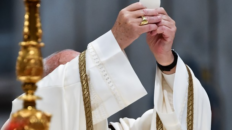Our Lady of the Miraculous Medal was the first great step toward the re-Marianization of the nineteenth century, preparing the great movement of souls that culminated with the proclamation of the dogma of the Immaculate Conception.
On November 27, 1830, Our Lady appeared to Saint Catherine Labouré in Paris and revealed to her the design of the Miraculous Medal. Its first great miracle was the deathbed conversion of a bishop who had sworn allegiance to the French Revolution.
The Miraculous Medal shows an image of Our Lady of Grace with her hands emitting rays of light, just as she appeared to Saint Catherine. This devotion to Our Lady of Grace on the medal marked a true renewal of devotion to Our Lady in Europe.
Devotion to Our Lady had been deeply eroded by Jansenism, which, although in great decline at the time, was replaced with more radical forms of Revolution, so that devotion to Our Lady left much to be desired. We can say that the Miraculous Medal was the first major step toward the ‘re-Marianization’ of the nineteenth century, preparing the great movement of souls that would culminate with the proclamation of the dogma of the Immaculate Conception.
With the use of the Miraculous Medal, extraordinary graces spread throughout the Church. It became a common custom to wear a Miraculous Medal around one’s neck or to place it on the chest of an impenitent patient while making the novenas and prayers prescribed by Our Lady. It seemed almost certain that the person would convert as a result. Through this devotion, Our Lady began to dispense many other graces to the world.
Moreover, this devotion is linked to two other very important devotions, which the Jansenists had attempted to bury: the devotions to the Sacred Heart of Jesus and the Immaculate Heart of Mary.
This animosity was very evident in the case of Bishop Scipion de’ Ricci of Prato and Pistoia, a man of the Enlightenment and Jansenist who combated devotion to the Sacred Heart and who also sought to bring about democratic reforms in the Church at the Synod of Pistoia (He was condemned by Pius VI in 1794). There was also the rejection of this devotion to the Sacred Heart by the House of Bourbon, which did not spread this devotion as it should have before the Revolution. On the back of the medal, Our Lady decided to place a letter M which stands for her holy name, and below this letter one sees the hearts of Jesus and Mary, linking these three highly significant devotions so hated by the Jansenists.
Not only did this devotion help defeat Jansenist sentiments, it also helped give rise to a colossal ultramontane movement in the philosophical, political and social fields. The results were a great nineteenth century movement devoted to Our Lady, the definition of papal infallibility, and the devotion to the Hearts of Jesus and Mary. Indeed, this all gave rise to a Counter-Revolution led by Blessed Pius IX and continued by Saint Pius X.
Because of its important role in Church history, this devotion retains all its relevance for Catholics today. In view of these past graces and consolations, it should be cultivated with great fervor.



